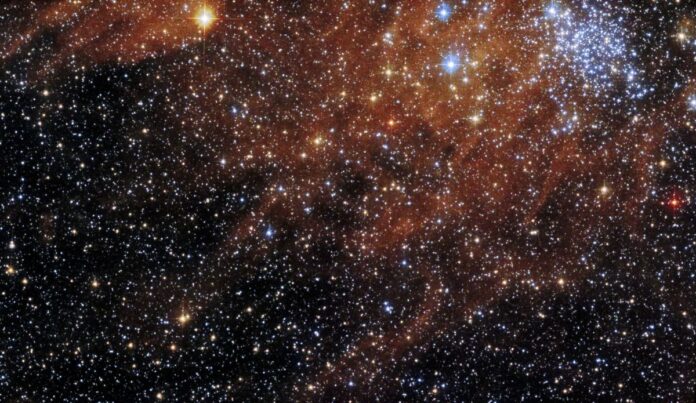Behold a fountain of star formation in the galaxy next door.
The Hubble Space Telescope is a critical tool for astronomers wishing to explore the nature of stars. One popular hotbed for study is the Large Magellanic Cloud (LMC), which is visible to observers in the Southern Hemisphere. The LMC looks like a strange smudge to the naked eye, but it’s actually a satellite galaxy of our own Milky Way. The LMC is close enough to us that Hubble can make out individual stars within it, but the chasm between both galaxies presents some challenges, too.
A new Hubble image highlights a region in LMC rich in stars. The top right of the image is a glittering sea of stars from KMHK 1231, an open cluster where stars are loosely bound to one another by gravity. The crimson color represents a dust and gas nebula that could give rise to new stars someday.
Related: The best Hubble Space Telescope photos of all time
“[Open clusters] tend to form from the same cloud of gas and dust, so their stars share characteristics like age and chemical composition, providing excellent laboratories for studying how stars form and evolve,” according to a NASA image description (opens in new tab) published on Dec. 6, 2022.
But there’s a challenge: The amount of light that these stars release isn’t immediately apparent. To learn their true nature, astronomers are looking at how the intergalactic space between Earth and the LMC soaks up the intense light of these stars.
“Hubble observed this particular cluster as part of a program to examine how ultraviolet light is absorbed by the material that exists in space between Earth and the Large Magellanic Cloud. This information helps astronomers discover how much light objects in the satellite galaxy to the Milky Way truly emanate, critical to determining the characteristics of these objects,” Hubble officials wrote.
Their efforts could yield new information about star formation, because open clusters provide “excellent laboratories for studying how stars form and evolve,” according to NASA.
And as Hubble collects science, it also captures beautiful images that all of us can enjoy.
Follow Doris Elin Urrutia on Twitter @salazar_elin (opens in new tab). Follow us on Twitter @Spacedotcom (opens in new tab) and on Facebook (opens in new tab).

